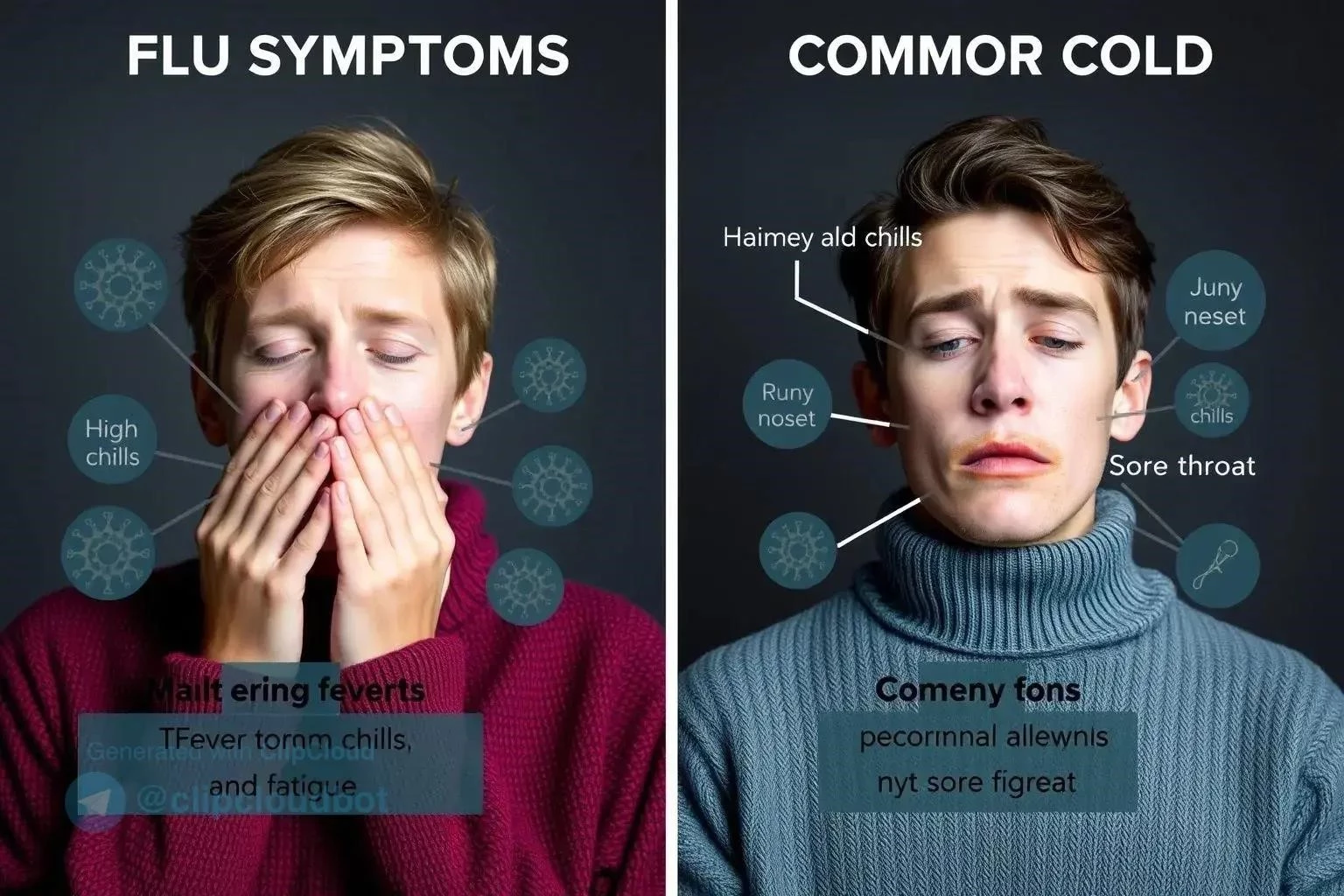Flu Symptoms vs. Common Cold: A Guide to What’s Trending This Season
Flu Symptoms vs․ Common Cold: A Guide to What’s Trending This Season
Navigating the sniffle season can be tricky․ Is it a common cold or the dreaded flu? This season, understanding the differences between these two viral infections is more important than ever․ This guide will help you decipher the clues, allowing you to better manage your health and seek appropriate care․ We’ll explore the distinct symptoms of both the flu and the common cold, empowering you to make informed decisions about your well-being․ Stay tuned to learn what’s trending in viral illnesses this year and how to stay protected․
Understanding the Differences
While both the flu (influenza) and the common cold are respiratory illnesses caused by viruses, they differ significantly in their severity and symptoms․ Understanding these key distinctions is crucial for effective management and treatment․
The Flu: Influenza is typically caused by influenza viruses A or B; It’s characterized by a sudden onset of symptoms that can be quite intense․ The flu often leads to more serious complications, particularly in vulnerable populations like young children, older adults, and those with underlying health conditions․
The Common Cold: Colds are caused by a variety of viruses, most commonly rhinoviruses․ Symptoms generally develop gradually and are milder compared to the flu․ Complications from a cold are less common and usually less severe․
| Feature | Flu (Influenza) | Common Cold |
|---|---|---|
| Onset | Sudden, abrupt | Gradual |
| Severity | Moderate to severe | Mild |
| Fever | Common (usually high, 100-102°F or higher) | Less common (may be low-grade) |
| Body Aches | Prominent, often severe | Mild or absent |
| Chills | Common | Less common |
| Fatigue | Significant, can last for weeks | Mild to moderate |
| Cough | Dry, often persistent | Mild to moderate, may be productive |
| Sore Throat | Sometimes present | Common |
| Runny/Stuffy Nose | Sometimes present | Common |
| Sneezing | Less common | Common |
| Headache | Common, often intense | Mild to moderate |
| Complications | Pneumonia, bronchitis, sinus infections, ear infections, worsening of chronic health problems | Sinus infections, ear infections, rarely pneumonia |
This table provides a clear comparison, highlighting the distinct characteristics of each illness․ Remember, this information is for general guidance and doesn’t substitute professional medical advice․ If you are experiencing severe symptoms or are concerned about your health, consult a healthcare professional for proper diagnosis and treatment․
Spotting the Flu: Key Symptoms and Severity
Influenza, commonly known as the flu, presents a distinct set of symptoms that often appear suddenly and can range in severity from mild to debilitating․ Recognizing these key indicators is crucial for prompt diagnosis and treatment․
Hallmark Flu Symptoms:
- High Fever: A fever of 100°F (37․8°C) or higher is a common flu symptom, although not everyone with the flu will experience a fever․
- Body Aches: Muscle aches and pains, often severe, are characteristic of the flu․ These aches can be widespread throughout the body․
- Chills: Feeling cold and shivering, even when bundled up, is a frequent flu symptom․
- Fatigue: Extreme tiredness and weakness are hallmarks of the flu; This fatigue can persist for several weeks, even after other symptoms subside․
- Dry Cough: A persistent, dry cough is often associated with the flu․ This cough can be severe and may worsen over time․
Other Potential Symptoms:
- Sore Throat: While less common than with a cold, a sore throat can occur with the flu․
- Runny or Stuffy Nose: Nasal congestion can occur, but it’s less prevalent than with a cold․
- Headache: Headaches, often intense, are common with the flu․
Severity and Complications:
The severity of flu symptoms can vary; While some individuals experience mild symptoms, others may develop severe illness requiring hospitalization․ The flu can also lead to serious complications, including:
- Pneumonia: A serious lung infection that can be life-threatening․
- Bronchitis: Inflammation of the bronchial tubes․
- Sinus and Ear Infections: Secondary bacterial infections can develop as a result of the flu․
- Worsening of Chronic Health Conditions: The flu can exacerbate existing conditions such as asthma, heart disease, and diabetes․
Seeking Medical Attention:
If you experience severe flu symptoms, such as difficulty breathing, chest pain, or persistent vomiting, seek immediate medical attention․ It’s also important to consult a healthcare professional if you are at high risk for complications, such as young children, older adults, pregnant women, and individuals with chronic health conditions․ Early treatment with antiviral medications can help reduce the severity and duration of the flu․
Remember: This information is for educational purposes and does not replace professional medical advice․ Always consult with a healthcare provider for diagnosis and treatment․
Common Cold Clues: Identifying the Usual Suspects
The common cold, a frequent visitor throughout the year, presents a familiar set of symptoms that are typically milder than the flu․ While a cold can be inconvenient, it rarely leads to serious complications․ Recognizing the usual suspects can help you distinguish a cold from other respiratory illnesses․
Primary Cold Symptoms:
- Runny or Stuffy Nose: Nasal congestion is a hallmark of the common cold․ You might experience a clear, watery discharge that can thicken and become yellowish or greenish over time․
- Sore Throat: A scratchy or painful throat is often one of the first signs of a cold․
- Sneezing: Frequent sneezing is a common way your body tries to expel the cold virus․
- Cough: Colds often involve a cough that can be either dry or produce mucus․
Other Potential Symptoms:
- Low-Grade Fever: While less common than with the flu, a mild fever can sometimes accompany a cold․
- Mild Headache: Headaches associated with a cold are typically less intense than those experienced with the flu․
- Mild Body Aches: Muscle aches and pains can occur but are generally mild compared to the flu․
- Fatigue: You might experience mild fatigue, but it’s usually not as debilitating as the fatigue associated with the flu․
Duration and Complications:
Common cold symptoms typically last for 7 to 10 days․ While most colds resolve without complications, some individuals may develop secondary infections, such as:
- Sinus Infections: Inflammation and infection of the sinuses․
- Ear Infections: Especially common in children․
- Pneumonia: Rarely, a cold can lead to pneumonia, a serious lung infection․
Managing Cold Symptoms:
Most cold symptoms can be managed with over-the-counter medications and home remedies, such as rest, fluids, and humidifiers․ If your symptoms worsen or persist beyond 10 days, consult a healthcare professional;
Important Note: This information is for general knowledge and does not substitute professional medical advice․ Always consult with a healthcare provider for diagnosis and treatment of any health concerns․
Prevention and Treatment: Staying Healthy This Season
Protecting yourself from the flu and the common cold involves a combination of preventative measures and appropriate treatment strategies․ By taking proactive steps, you can significantly reduce your risk of infection and minimize the impact of these seasonal illnesses․
Prevention Strategies:
- Vaccination: The annual flu vaccine is the most effective way to prevent influenza․ Consult with your healthcare provider about the appropriate timing and type of vaccine for you․
- Hand Hygiene: Wash your hands frequently with soap and water for at least 20 seconds, especially after coughing, sneezing, or touching surfaces in public areas․ Use an alcohol-based hand sanitizer when soap and water aren’t available․
- Respiratory Etiquette: Cover your mouth and nose with a tissue when coughing or sneezing, and dispose of used tissues promptly․ If a tissue isn’t available, cough or sneeze into your elbow․
- Avoid Close Contact: Limit your contact with individuals who are sick, and avoid touching your eyes, nose, and mouth․
- Healthy Lifestyle: Maintain a healthy immune system by getting enough sleep, eating a balanced diet, exercising regularly, and managing stress․
- Clean and Disinfect: Regularly clean and disinfect frequently touched surfaces, such as doorknobs, light switches, and countertops․
Treatment Options:
Flu Treatment:
- Antiviral Medications: Prescription antiviral drugs can help reduce the severity and duration of the flu if taken within 48 hours of symptom onset․ Consult your doctor promptly if you suspect you have the flu․
- Symptom Relief: Over-the-counter medications can help alleviate flu symptoms, such as fever, aches, and congestion․ Rest and fluids are also essential for recovery․
Common Cold Treatment:
- Symptom Management: Over-the-counter medications can help relieve cold symptoms like sore throat, congestion, and cough․ Rest, fluids, and humidifiers can also provide relief․
- Antibiotics are not effective against colds: Colds are caused by viruses, so antibiotics are not necessary and won’t help with recovery․
When to Seek Medical Attention:
Consult a healthcare professional if you experience severe symptoms, such as difficulty breathing, chest pain, or persistent vomiting․ Individuals at high risk for complications should also seek medical advice promptly․
By prioritizing prevention and seeking appropriate treatment, you can navigate cold and flu season effectively and stay healthy throughout the year․ Remember, this information is for educational purposes and does not replace professional medical advice․ Always consult with a healthcare provider for diagnosis and treatment․






